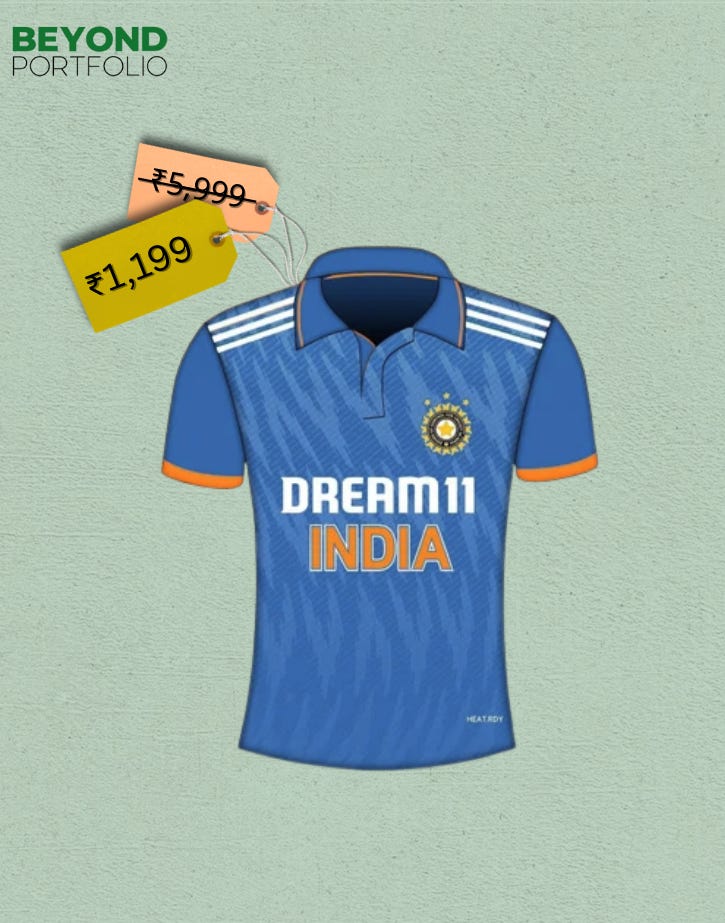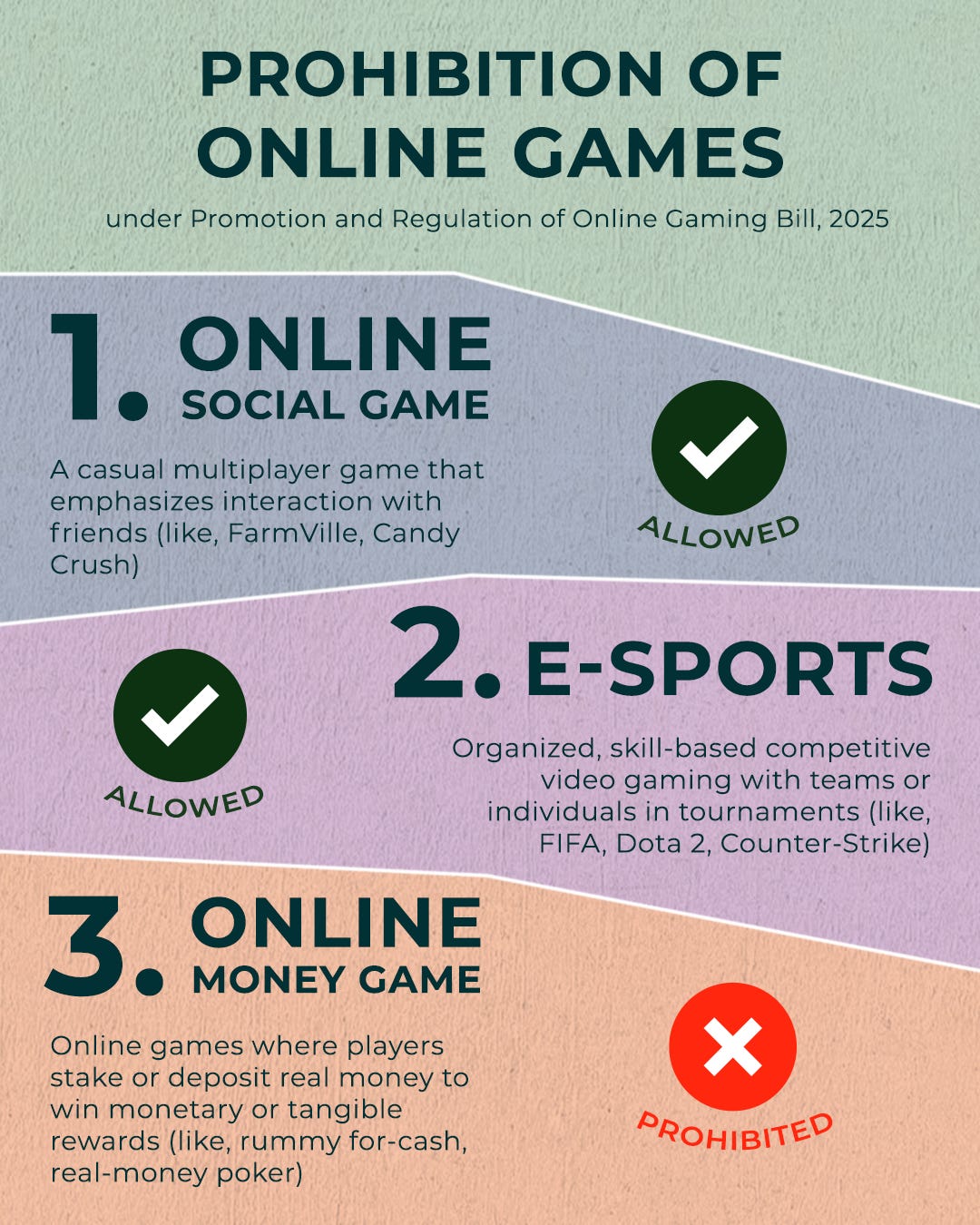Cursed cricket jersey caused the Dream 11 ban?
T20 jerseys are being sold at an 80% discount, dropping from INR 5,999 to just INR 1,199 on Adidas' site, with kids' versions hitting only INR 499 - all because of its recent sponsorship collaboration! What’s happening?
Sponsoring Team India doesn't come cheap. The costs differ by spot: the front of the jersey is the priciest at INR 3.5 crore per bilateral match (like India vs. Australia) and INR 1.5 crore for multilateral events (like ICC World Cup).
The back of the jersey is comparatively less coveted, costing 20-40% lesser. Bat stickers on players' bats cost INR 50 lakh to INR 2 crore per series, based on the player's fame. Branding right on the field isn’t cheap either: pitch mats fetch about ₹10–50 lakh per match.
Brands opt for sponsoring Indian cricket due to its massive reach - i.e. over 1.5 billion fans globally! Then the brand recall through association with star players like Virat Kohli and Rohit Sharma is something extraordinarily unparalleled.
Even though Indian cricket stands for dignity and heritage, there’s a curious phenomenon springing up in the sponsorship world called the “jersey jinx”.
For nearly a decade, it seems that every sponsor adorning Team India’s jersey has faced downfall, not long after coming on board.
So, is the jersey really cursed or it’s just a poor timing? (Reach the bottom-most section for quick reveal!)
Let’s begin from the beginning…
In 2024, India’s real-money gaming world, from fantasy sports to poker and rummy, was booming like anything. It was worth $3.7 billion, made up 86% of all online gaming revenue, and drew in about 591 million gamers - that’s 1 in every 5 gamer worldwide!
Digital money gaming has widely reported to cause addiction, financial distress, and psychological harm. This was particularly common among young and economically vulnerable groups, with reports of compulsive behavior leading to suicides and debt. IT Minister Ashwini Vaishnaw quoted a figure that in the last 2.5 years, Karnataka witnessed 32 suicides linked to online gambling, highlighting a serious and mounting mental health crisis.
The government have, time and again, cited manipulative algorithms and unfair practices that undermined transparency, while also linking these games to illegal activities, such as, money laundering, tax evasion, and terrorism financing.
During the IPL, the number of users nearly triples, showing how cricket season drives a huge surge in activity. This spike puts extraordinary pressure on banks’ IT infrastructure.
Next up, we're diving into the disastrous Gurgaon rains - what no one else about the 200 cr+ ultra-luxury flats in Gurgaon.
A special take on ethanol prices, some exciting Diwali Mahurat gift and more lined up just for you.
Drop your email ID in the comments to get early access for that extra edge!
Despite all this, courts had long defended these games in a ‘skill versus luck’ argument.
The Supreme Court has repeatedly decided (from the 1950s through to 2015 and later) that if skill is the bigger factor in determining the outcome of a competition, it isn’t gambling under the Public Gambling Act, 1867. For example, in Satyanarayana (1968), Rummy was ruled a game of skill, because although chance plays a part (like how cards are dealt), a player’s memory, strategy, and decisions about what to discard are what really win or lose.
If that sounds non-common-sensible of the SC, then understand this-
Courts use what’s called the “predominance test” (or “dominant factor test”), which means that even if a game has some luck involved, if skill is the main thing that influences who wins, it gets treated as a skill game.
. . .
Betting and gambling are normally state affairs under the Constitution. But since these are online platforms cut across state borders, the Centre stepped in by framing the issue as a national, internet-regulation problem.
And everything changed on August 20, 2025. The old Public Gambling Act? Well, it does not explicitly cover online gambling. So, the Parliament passed the new Online Gaming Bill.
Now, any game that involves real-money stakes was banned - no more skills versus luck discussion required!
So, what all is exactly banned?
Here are the three categories defined by the Online Gaming Bill, 2025:
1. Online Money Game (OMG)
This includes any online game, whether based on skill, chance, or both—where players pay money, credits, tokens, or similar stakes expecting a monetary or equivalent return.
2. E-Sport
These are organized, competitive games played in multiplayer format with clear rules. Victory depends solely on skills like strategy, mental agility, or physical coordination. E-sports must be recognized under the National Sports Governance Act, 2025, and prizes or fees are allowed but there’s no betting or wagering involved.
3. Online Social Game (OSG)
These are casual or educational games meant for entertainment, social interaction, or skill development. They may charge subscription or access fees, but do not involve any form of betting or stakes.
What’s Prohibited? Running or advertising OMGs in any form is a crime. Banks, payment gateways, or other intermediaries cannot process or authorize payments for these OMGs.
What Is Allowed? Competitive, skill-based gaming events recognized under the National Sports Governance Act, 2025, and registered with the designated authority are permitted. Players may pay participation fees and win prize money, but betting is explicitly forbidden. These may include access or subscription fees, provided they are not used as entry-to-win stakes.
Impact and Worries
The ban puts over 2 lakh jobs in danger, which could wipe out ₹15-20 thousand crore in annual revenue. This is causing more than 400 gaming start-ups to close. Listed peers like Nazara Technologies are down by 7-20%.
The ripple effects of the ban are already evident across the industry. Ad and media companies now face a ₹2,000-4,500 crore hole in sponsorship spend, the IPL has lost Dream11 as a shirt partner, and payments firms are missing ₹20-30 thousand crore in monthly transaction value as users shift to offshore sites.
Another fallout is the impact on creators and influencers who often earn 20–30% of their income from these platforms.
. . .
As you must have heard, prohibition rarely kills demand, it diverts it.
Banning something doesn’t kill demand—it just pushes it underground. When legal options disappear, people turn to unsafe, illegal sources. To avoid that, bans must be paired with a regulated alternative: verified operators, proper identity checks, fair pricing, ways to self-exclude, and clear rules so people are protected and saying “legal” means real.
So, what could have been done instead?
India’s approach centered on prohibition and takedown powers rather than channeling demand into a supervised market.
Critics argue that this approach is too heavy-handed, it may unfairly punish legitimate operators and reduce protection for consumers if OMG ultimately goes underground.
Moreover, offshoring via crypto and informal channels reduces transaction traceability for Indian authorities, increasing exposure to scams, non‑payment, laundering, and potential terror‑finance vectors—precisely the risks the law sought to curb.
Instead of a ban, India could have replaced prohibition with a channelization-and-protection model proven in the UK, EU, and Australia.
These nations have implemented comprehensive statutory regulatory frameworks like, mandatory licensing for operators, strict anti-money laundering (AML) rules, robust user identity checks (age, location), tools for self-exclusion, transparent reporting, limits on advertising/promotional content, and consumer protections (e.g., clear disclosures, refunds, dispute channels).
Enjoying your read? Get a Free early access to our next issue or request a topic here.
Now, coming back to where we started from - the conspiracy theory.
Yes, that’s what we call it.
We as humans, love a good drama, and that’s what conspiracy theories are for.
The fall of Dream11 sparked wild chatter about a "Jersey Jinx" curse dooming any brand that dares to have its logo on the Men in Blue kit. Several sponsors have indeed crashed after partnering with the Indian cricket team:
Sahara (2001–2013), which tanked due to massive SEBI fraud probes and its founder's arrest;
Star India (2014–2017), hit by antitrust battles and forced mergers;
Oppo (2017–2019), squeezed by India-China tensions and weak sales returns;
Byju's (2019–2023), buried under insolvency, defaults, and edtech meltdowns; and now
Dream11 (2023–2025), forced out by the 2025 Online Gaming Bill that banned real-money games.
But here's the twist: plenty of big companies have faced similar consequences without ever touching cricket sponsorship. Be it Paytm, rocked by RBI banking bans and stock plunges; or Yes Bank, sunk by fraud scandals and bailouts.
On the flip side, not every cricket sponsor flops as well. For example, ITC (Wills, 1993–2001) thrived post-deal, evolving into a diversified giant.
Experts say the real culprits aren't curses but volatile industries, abrupt disruptions like regulatory crackdowns, revenue collapses, or shaken ecosystems.
Sahara (sponsor) crumbled from financial fraud, much like Vijay Mallya's Kingfisher Airlines (non-sponsor) imploded from debt; Oppo (sponsor) faded amid global trade wars, similar to how Zomato (non-sponsor) battled market slumps.
The only true common thread between jinxed sponsors that failed and those that didn't?
Some survived the public scrutiny while some others didn’t.
Being on the Indian cricket jersey is like having your brand plastered across 700 million TV sets- an unmatched exposure. Yet, with that visibility comes relentless scrutiny. Harsh Goenka humorously summed it up:
Want to test your brand’s survival skills? Forget the stock market. Try sponsoring the Indian cricket team jersey!
These brands often come from volatile or high-growth industries—like edtech, consumer tech, real-money gaming—that need rapid brand visibility to fuel investor confidence. The cricket jersey grants that visibility… but it also exposes weak business fundamentals.




